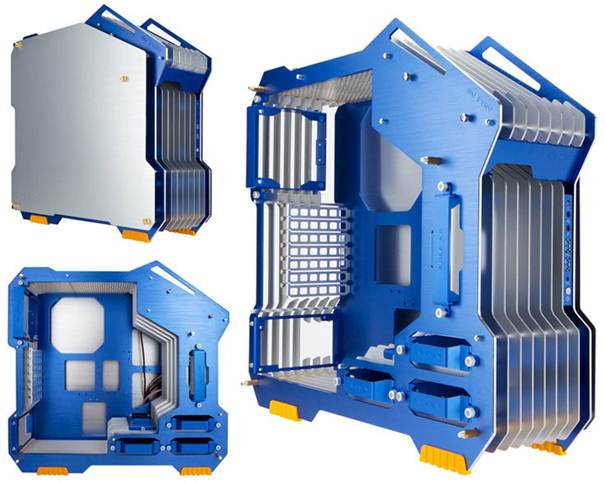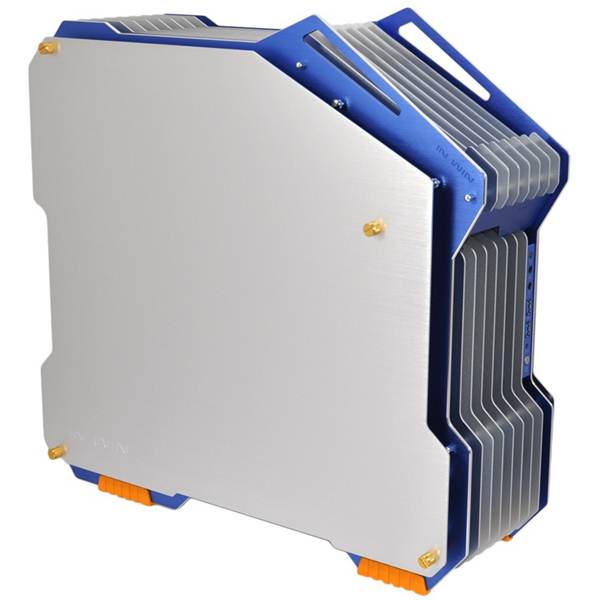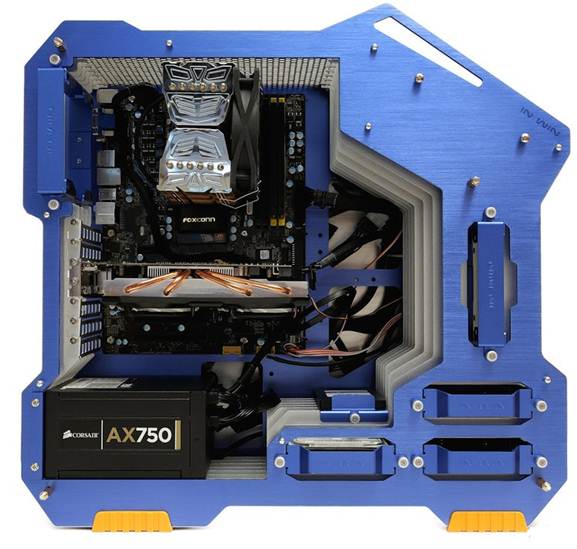In Win chucks the case design manual out the
window with this all-aluminium, fanless chassis
The premium case market is traditionally
reserved for water-cooling-friendly beasts. Cases such as the SilverStone TJ11
and Lian Li PC-V2120 retail for more money than many of the components they
house, but are constructed from the finest aluminium, and have oodles of
features and expandability. Every once in a while, though, comes a case that
chucks the manual for traditional case design out of the (perspex) window.
Standing proud on its orange silicon feet, the In Win H-Frame is a sight to
behold.

In
Win H-Frame
Although its unusual styling will probably
offend some people to their core, we think the H-Frame looks fantastic. It features
11 sheets of diamond-cut aluminium, sharply angled and beautifully finished in
silver and blue. These sheets are arranged vertically, separated by golden
spacers along some rods, forming the case’s iconic open-air design.
The H-Frame is open from top to bottom and
front to back, and sealed only by the two flat side panels. Although there are
obvious benefits for airflow, this design provides an easy escape for noise,
and an open invitation, complete with champagne reception, for dust. The metal
mesh fitted to the roof also spoils the view from above, and it isn’t very well
attached either, but it’s probably been included as a necessary precaution to
help prevent hardware-destroying objects from falling into the case.
The front panel is nothing to shout about
either, especially for a case costing $399, but the power and reset buttons,
audio jacks and two USB 3 ports are sufficient for most people. The recessed
reset button is small enough to require a pin (or the end of a pen) to press,
and the power and hard drive access LEDs are blue and orange respectively,
matching the case’s colour scheme. Completing the external connections is a
roof-mounted USB 2 port. This is easy to access, and can be used for charging
phones and gadgets, which can be rested on the slanted section of the H-Frame’s
roof.

In
Win chucks the case design manual out the window with this all-aluminium,
fanless chassis
In a bold move, In Win has chosen not to
supply a single fan with the H-Frame, relying instead on the case’s open-air
design to provide sufficient airflow to your hardware. In theory, and with the
right hardware, this leaves open the possibility of a silent system that relies
totally on passive cooling. Single 120mm fan mounts are provided on the front
and rear for those who want to use them, although the case doesn’t cater for
water cooling at all.
Loosening the four golden caps on each side
panel enables you to pull them straight off - they don’t need to be slid and
locked in place like most case panels. Doing so reveals the gorgeous anodised
blue interior, which makes us lament the lack of a side window. With
thumbscrews for just about everything, rubber strips on which the PSU rests and
a large CPU backplate cut-out, building a system inside the H-Frame is
relatively pain-free, although pre-installed motherboard mounts would have
helped.
With only four internal drive mounts,
storage space is limited - a sacrifice made in the name of style. The drive
bays, as well as the two fan mounts, feature spring-loaded thumbscrews and come
out of the case completely when these are unfastened. This all-metal design
means this process creates an unpleasant grinding noise, but at least it
ensures that fans and drives are mounted very securely. Each bay has its own
hot-swap connector too, making drive installation even simpler. However, the
wiring for these connectors is non-detachable and thus has the potential to
leave you with a big surplus of cables.

This
is easy to access, and can be used for charging phones and gadgets, which can
be rested on the slanted section of the H-Frame’s roof.
Meanwhile, the single 5.25in bay is angled
so that installed drives will slide around 45 degrees downwards, adding to the
unique form of the H-Frame. It’s secured using thumbscrews; as with the 3.5in
bays, this means you can remove the entire enclosure from the case.
Interestingly, when empty, the drive enclosure’s rear, which has a small
cutaway section for drive cables, faces forwards, acting as a cover for the
front of the case. With your optical drive in place, you then need to replace
the enclosure facing the opposite direction to give your drive room to open.
For such a great-looking case, it’s a shame
the front panel cables aren’t pre-sleeved in black like those of the hot-swap
connectors. However, for the job of actually tidying away cables, In Win
provides three holes that let you route cables behind the motherboard tray -
one next to the PSU and two adjacent to the motherboard itself, although these
don’t have rubber grommets.
Meanwhile, to prevent the side panel
bulging out from the cable equivalent of a spaghetti junction pressing on it,
it’s necessary to spread out the wires behind the motherboard tray, so a few
more than the five provided zip ties would have been handy, as would some clips
to which you could tie them. These aren’t disastrous omissions, but they should
be standard in the design of such an expensive case.
Cooling
With no direct airflow of its own, it
wasn’t surprising to see both the CPU and GPU delta T results rise to relatively
high temperatures during our stress test. The GPU, which has its fan speed
locked to 30 per cent in our tests, suffered considerably, posting a delta T of
52°C. The CPU delta T of 54°C, however, is very respectable given the
circumstances. It’s just 1°C higher than both the Lian Li PC-V2120 and the
Cooler Master Cosmos II, with the latter running

The
GPU, which has its fan speed locked to 30 per cent in our tests, suffered
considerably, posting a delta T of 52°C.
its fans on their fastest and noisiest
speed.
Not wanting to waste the opportunity, we
also chucked in a couple of Thermaltake high-airflow 120mm fans to fill the
H-Frame’s fan mounts and repeated our test. The fans had the effect of knocking
a massive 9°C off the CPU delta T, and 4°C off the GPU delta T. Although this
demonstrates the effectiveness of the open-air design, particularly for the
CPU, the noise from the case with the two fans was almost unbearable. Even
without the fans, noise leakage from the open case was fairly high.
Conclusion
On paper, the In Win H-Frame costs over
$390 yet includes no fans, has few features, limited expandability and
below-average cooling - we won’t be recommending it for your next build. It’s
equally apparent, however, that it isn’t designed for mass appeal, and is more
of an exercise in style over substance, geared towards those with cash to spend
on something that stands out. With its open-air design, eye-catching colour
scheme and flawlessly cut aluminum sheets, that’s exactly what the H-Frame
achieves.